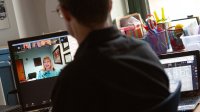Virtual Coaching Takes Off
When video is at the core of instructional coaching, the entire process becomes more efficient and effective.
Your content has been saved!
Go to My Saved Content.As a literacy coach working in a rural area with 10 school districts spread out over 2,000 square miles, I’ve long been accustomed to providing professional learning to educators through large, face-to-face group sessions and small professional learning communities, and virtually using Zoom. But given the geographic area I need to cover, with approximately 100 K–3 teachers, and as I am my organization’s only literacy coach, even before the pandemic the one-on-one instructional coaching that is often seen as a gold standard was limited.
Given the demands of those circumstances, I got creative. I spent countless hours reading various resources and creating structures and protocols for a virtual coaching program; that foundational work served me well once the pandemic hit and it became imperative that we roll out virtual coaching in order to coach safely and to support teachers through the incredible instructional pivot they faced.
In fall 2020, we hit the ground running with a virtual coaching program that is robust and effective and, importantly, provides the flexibility that teachers need. This approach has entirely changed the way I do my work. Here’s a distillation of what I’ve learned.
Video as the Cornerstone
Coaches and athletes have used video to improve for years, to the point where reviewing footage of plays is core to training. I’ve found that when teachers watch a recording of themselves teaching, they often see things differently than when they are in the moment. Providing teachers the opportunity to see their teaching and student learning in action is powerful; add collaboration with a coach to that experience and it becomes even more so.
When I have teachers view themselves teaching a lesson, I ask them to make time-stamped reflective comments to share with me. A coaching platform we use called Sibme makes this process super-simple (it allows teachers to record, upload, edit, annotate, and share video), but video can be taken with any device, and comments can be shared with timestamps in Google Docs too. The coach can then view the recording and the teacher’s reflections. I respond with my own time-stamped comments.
The same approach works for coaching conversations. I ask teachers for permission to record our sessions so I can review the recordings and increase my own effectiveness through self-reflection. Additionally, another coach and I often share our recordings with each other, so the process mirrors what we do with teachers: We share our recordings, reflect, and offer feedback. Just as with teachers, the reality of what I see in the recording doesn’t always match the perception I had at the moment.
Asynchronous Collaboration
Teachers are so busy, and it is sometimes easier for them to collaborate outside of their preparation periods, when they’re often distracted by all the things they need to do—and by how little time they have before their students return to them.
Because of the asynchronous nature of watching and reflecting on lessons, providing time-stamped questions and comments, and collaborating online, there’s more flexibility that helps make our program successful and sustainable. Also, this asynchronous structure allows for deeper reflection and time to gather any research or resources that may be needed.
Structured Zoom Meetings
After collaborating asynchronously, I set up a Zoom meeting that is paired with a very clear agenda that helps me to make meaning of the collaboration. For example, together with a teacher I can create a goal of increasing student phonemic awareness skills with the action steps of implementing word sorts, using Elkonin box activities in small groups, and creating opportunities for students to practice blending letter sounds.
Sometimes the teacher and I work closely to plan these activities, and sometimes after we talk through it, the teacher does specific planning on their own. I make myself available for various levels of supports, depending on teacher needs.
Coaching Summaries
I use a Coaching Summary Form, created in Google Docs, to keep track of the logistics of meetings, such as dates and times, highlights of our conversation, our goals and action steps, and goal-related resources. Resources may include items such as research, videos, websites, directions for specific activities, or sample lessons. The teacher and I share this document so that both of us can review it at any time.
The virtual coaching has been embraced by classroom teachers. After I did my first virtual coaching assignment, the principal at the school provided this encouraging feedback: “The virtual coaching is helping the teachers to recognize things that they might not have seen before. This is helping them to become better educators for our students and better teammates for the staff.”
My job is all about empowering teachers, and never has that been more important than it is now. Virtual coaching has helped the teachers I work with so they can better meet the needs of their students, but it’s also been energizing to me as an early literacy instructional coach: I can offer teachers I work with personalized feedback that’s deeply connected to their day-to-day work, no matter how far we are from each other physically. And virtual coaching helps teachers take ownership of their learning in refreshing ways, so they’re more likely to engage in work that impacts student achievement. Virtual coaching doesn’t limit my work or my effectiveness—it dramatically enhances both.
